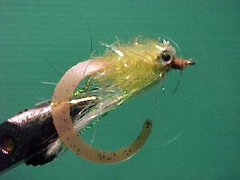When this fly was fist developed in the mid 90’s it was intended as an estuary fly for bream and flathead on the South Coast of NSW.
With outstanding results in that estuary role it’s use has extended to temperate and tropical fresh and salt water applications where it has taken flathead, bream, whiting, trevally, mullet, tailor, flounder, coral trout, mangrove jack, grunter, saratoga and bass etc.
Native fresh water Bass are a favourite of mine and if I could only carry one type of sinking fly to target then with the Black Estuary/Bass fly would be it.
This fly fishes well on an floating line in water up to 1 meter deep and in deeper water on an intermediate line through to full sinking lines with the choice of line depending on the depth and run of the water.
For most species the best strategy is to cast into structure or over drop offs and then count the fly down to the desired depth and then retrieving the fly with repeated short strips followed by short stops. This process can be applied throughout the water column or along the bottom in much the same way giving the sort of retrieve you may use if you were fishing a soft plastic. A good alternative retrieve is a steady roll so that the rubber tail is active throughout the retrieve.
Whether fishing this fly on a floating line or sinking line keep in contact with the fly as takes can be at any time from when the fly is settling through the water column right through to the lift and they can range from subtle inquiries to dramatic whacks.
Unfortunately, in the process of Tiewell being sold and reinvented the larger rubber tails for size #2/0 estuary fly never came back on the market. I have searched for and tried alternatives with the same or similar properties and unfortunately there are limited options. What I have come up with is using the rear end of the 2.5″ Z Man Grub Z which if gut down is a fantastic alternative. I have stuck with all the other materials from my #2/0 and I am pretty pleased with what I have come up with.
Some proven colour examples are:
Fishing drop off’s – chartreuse to gold bodies with complementary beard and a pumpkin coloured tail.
As an all rounder in clearer water – tie it with cherry crystal chenille, pumpkin tail and black beard.
For Bass – dress it in black crystal chenille, pumpkin tail and with a purple and black beard.
The hook type and size and the dumbbell eyes/weight are important because I have found that thicker hooks such as the 34007 Mustard are too thick and heavy and wont turn over unless you use a much heavier eyes and then the fly is hard to cast and the action of the tail may be impaired.
 |
 |
 |
Materials trout version of estuary fly
| Hook | Thread | Eyes | Tail | Body | Beard / legs |
|---|---|---|---|---|---|
| Size 2 Gamakatsu SS15/T. | Olive | 5/32” or 3/16″ real or dumbbell eyes | Pumpkin / black flake coloured small size rubber fly tails. | Chartreuse crystal chenille. | Sparkle flash – light olive pearl and or chartreuse |
Process





